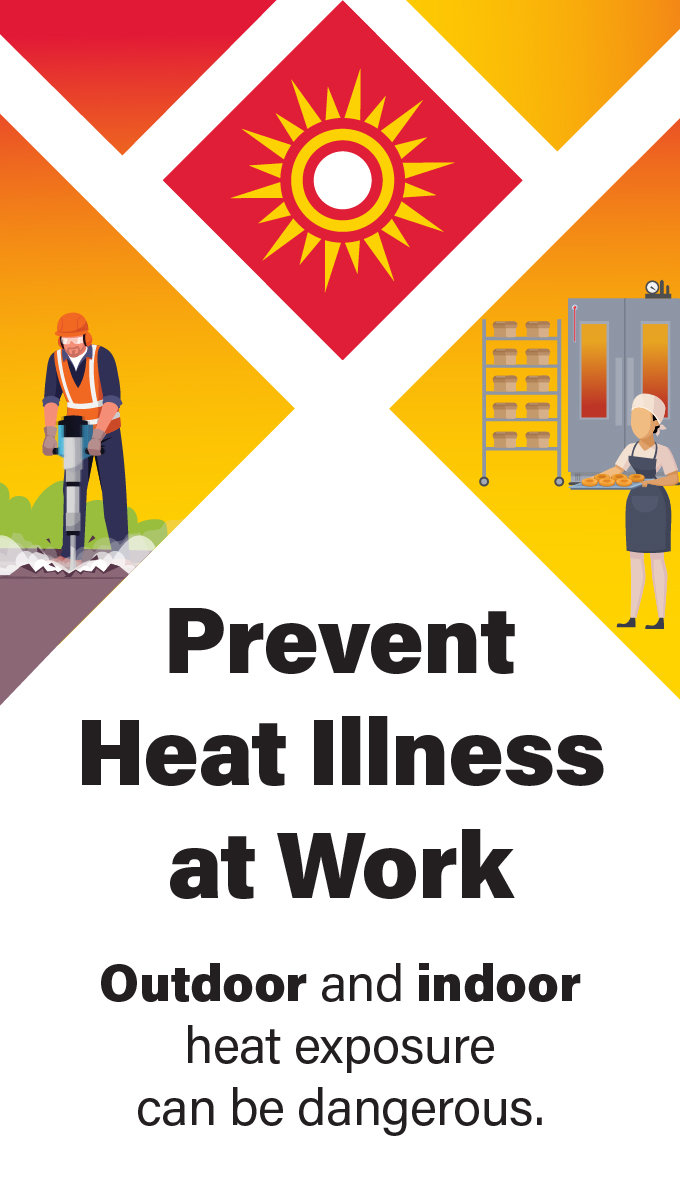by Brianna Crandall — June 27, 2022 — For the first time, the U.S. Department of Labor’s Occupational Safety and Health Administration (OSHA) has launched a National Emphasis Program to protect millions of workers from heat illness and injuries, whether from working outdoors or indoors. Through the program, OSHA will conduct heat-related workplace inspections before workers suffer completely preventable injuries, illnesses or, even worse, fatalities.
 Heat illness affects thousands of indoor and outdoor workers each year and is tragically the leading cause of death among all weather-related workplace hazards. Workers in outdoor and indoor work settings without adequate climate-controlled environments risk hazardous heat exposure. Statistics show workers of color are exposed disproportionately to hazardous levels of heat in essential jobs in these work settings.
Heat illness affects thousands of indoor and outdoor workers each year and is tragically the leading cause of death among all weather-related workplace hazards. Workers in outdoor and indoor work settings without adequate climate-controlled environments risk hazardous heat exposure. Statistics show workers of color are exposed disproportionately to hazardous levels of heat in essential jobs in these work settings.
Reducing workplace heat-related illnesses and injuries is said to be a top priority for the Department of Labor, and this National Emphasis Program is a way to immediately improve enforcement and compliance efforts, while continuing long-term work to establish a heat illness prevention rule. These efforts are part of a larger, interagency Biden-Harris administration effort to protect workers and communities from extreme heat and rising temperatures resulting from climate change.
U.S. Secretary of Labor Marty Walsh, who joined Vice President Kamala Harris at the Sheet Metal Workers Local 19 Training Center in Philadelphia to announce the new enforcement program, stated:
Tragically, the three-year average of workplace deaths caused by heat has doubled since the early 1990s. These extreme heat hazards aren’t limited to outdoor occupations, the seasons or geography. From farm workers in California to construction workers in Texas and warehouse workers in Pennsylvania, heat illness – exacerbated by our climate’s rising temperatures — presents a growing hazard for millions of workers. This enforcement program is another step towards our goal of a federal heat standard. Through this work, we’re also empowering workers with knowledge of their rights, especially the right to speak up about their safety without fear of retaliation. I’m grateful for the Vice President’s leadership on this issue, and for her demonstrated commitment to keeping workers safe on the job.
The OSHA website lists these industries among those where workers have suffered heat-related illnesses:
| Outdoors | Indoors |
|---|---|
| Agriculture | Bakeries, kitchens, and laundries (sources with indoor heat-generating appliances) |
| Construction – especially, road, roofing, and other outdoor work | Electrical utilities (particularly boiler rooms) |
| Construction – roofing work | Fire Service |
| Landscaping | Iron and steel mills and foundries |
| Mail and package delivery | Manufacturing with hot local heat sources, like furnaces (e.g., paper products or concrete) |
| Oil and gas well operations | Warehousing |
As part of the program, OSHA will proactively initiate inspections in over 70 high-risk industries in indoor and outdoor work settings when the National Weather Service has issued a heat warning or advisory for a local area. On days when the heat index is 80°F or higher, OSHA inspectors and compliance assistance specialists will engage in proactive outreach and technical assistance to help stakeholders keep workers safe on the job. Inspectors will look for and address heat hazards during inspections, regardless of whether the industry is targeted in the NEP.
Assistant Secretary for Occupational Safety and Health Doug Parker added:
Our goal is to make it safe for workers in hot indoor and outdoor environments, so that they can return home safe and healthy at the end of each day. Working together, we can ensure workers know their rights and employers meet their obligations in order to protect workers from the growing dangers of extreme heat.
OSHA’s area offices will engage in outreach to unions, employers in target industries, and other organizations committed to advancing protections for underserved workers. The agency’s On-Site Consultation Program, a free and confidential health and safety consulting program for small- and medium-sized businesses, will assist employers in developing strategic approaches for addressing heat-related illnesses and injuries in workplaces.
Last fall, in the Biden-Harris Administration’s first year in office, OSHA published an Advance Notice of Proposed Rulemaking to initiate the rulemaking process towards a federal heat standard and says it is committed to using all tools at its disposal to reduce heat hazards through a combination of enforcement, outreach and compliance assistance.
OSHA held a Heat-Related Hazards public stakeholder meeting (now available on YouTube) in May to discuss the agency’s ongoing activities to protect workers from heat-related hazards, including the Heat Illness Prevention Campaign, compliance assistance activities and enforcement efforts.
Learn more about working in outdoor and indoor heat environments and OSHA’s National Emphasis Program to protect workers across the nation from the increasing threat of heat-related illness, on the OSHA website. A video featuring Jim Barber, who shares his story on the loss of his son from heat illness on a New York job site (“Remembering Tim: A life lost to heat illness at work”), is available on YouTube.




